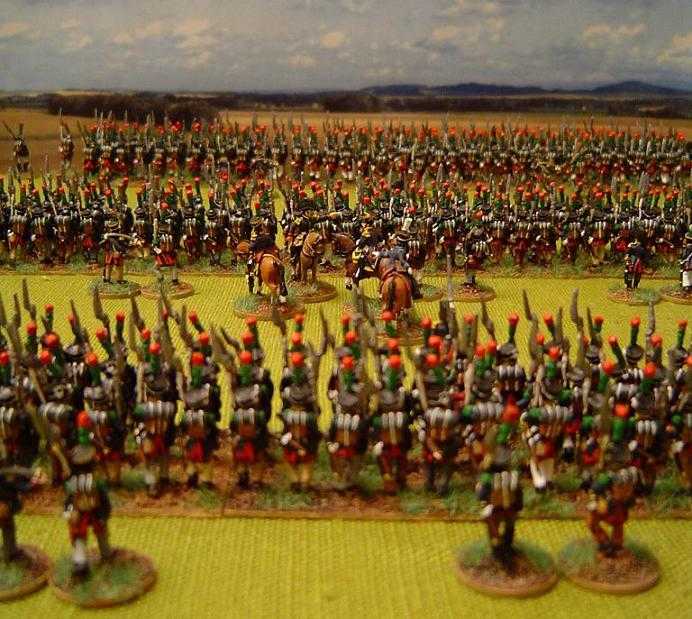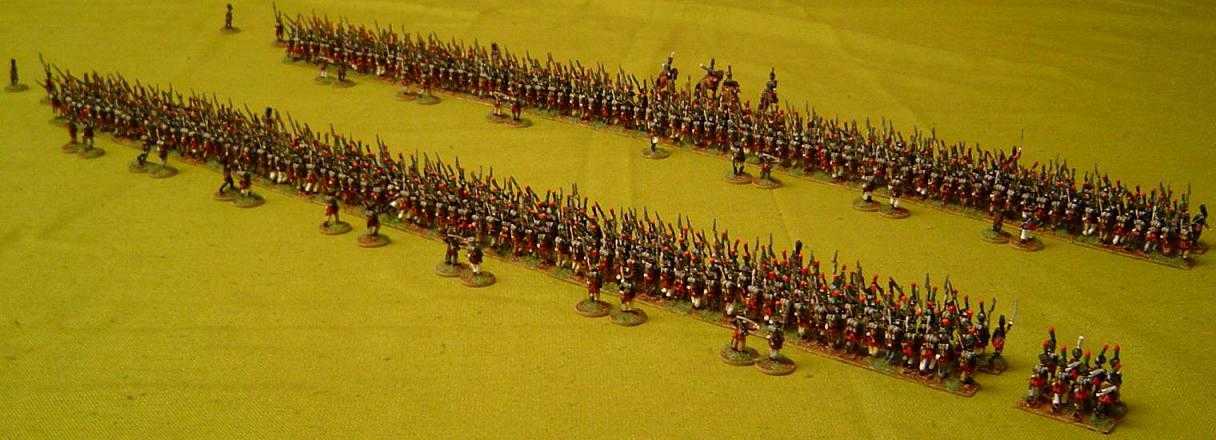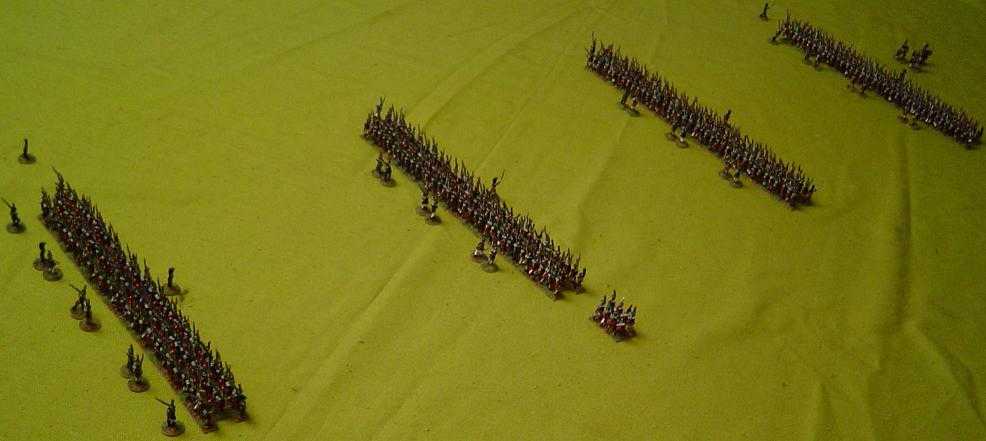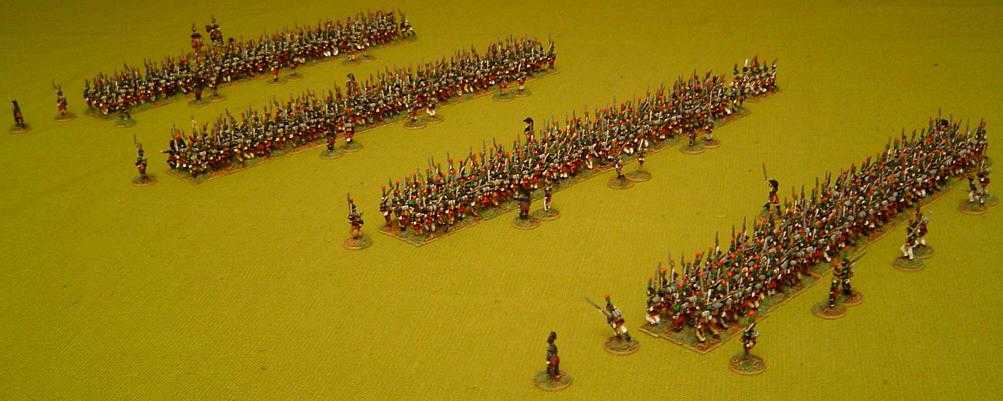En colonne

En colonne, chaque peloton est positionné de la même manière qu’en ligne, avec cependant les différences suivantes :
- le capitaine chef du peloton se place en avant du centre de son peloton, remplacé à sa place (à droite du 1er rang) par le sous officier de remplacement (le 1er sergent) qui quitte donc la droite du 3ème rang (d’où son appellation).
- Le 2ème sergent, qui était précédemment en serre file derrière la gauche du peloton, se place à la gauche du 1er rang du peloton
- Le caporal d’encadrement du bataillon quitte sa position à gauche du 4ème peloton et se place en serre-file, à deux pas derrière le 3ème rang du 4ème peloton.

Peloton en ordre de bataille, le bataillon est ployé en colonne Platoon in order of battle, the battalion is deployed in column
Un régiment d’infanterie de ligne (à 6 pelotons) qui voudrait monter à l’assaut d’une position ennemie se ploierait en « colonne par division », c'est-à-dire une colonne présentant un front de 2 pelotons.
Cependant, les Voltigeurs n’ayant que 4 pelotons, on peut supposer qu’ils préféreraient à la « colonne par division » la « colonne par peloton », avec donc un seul peloton de front.
En effet, le ploiement du bataillon en « colonne par division » montre que ladite colonne ressemble plutôt à une double ligne, et manque de profondeur, ce qui n’est pas idéal pour une manœuvre destinée bousculer l’ennemi, tandis que la « colonne par peloton » offre une profondeur plus propice à mener à bien cet objectif.

Colonne “par division” Column “by Division”
En colonne par peloton, la position du chef de bataillon n’est pas fixée, il pourra par exemple se tenir en avant de la formation, ou bien sur le côté de la direction à huit ou dix pas des guides généraux et à hauteur du centre du bataillon. L’adjudant-major est à gauche du 1er peloton, l’adjudant sous-officier à gauche du 4ème peloton, ils sont à deux pas du guide de gauche de ses pelotons (le 2ème sergent), et surveillent la direction de la marche et l’alignement des guides des 4 pelotons.
La garde du fanion garde sa place à gauche de la deuxième section du deuxième peloton.
Les tambours ne se positionnent pas entre deux pelotons, afin de ne pas empêcher la colonne de se refermer par la suite. Ils se positionnent donc ou bien à la droite du 3ème peloton, ou bien en queue de la formation, plus rarement en tête.
La colonne sera soit « à distance » ou « ouverte », c'est-à-dire que l’intervalle entre deux pelotons successifs sera équivalent à la largeur d’un peloton, soit « à demi distance », l’intervalle entre deux pelotons successifs sera alors de la largeur d’une section, ou encore « serrée en masse », dans ce dernier cas les intervalles sont réduits au minimum, trois pas entre les 3e et 1er rangs des pelotons successifs, les serre-files sont à un pas derrière le 3e rang, cette dernière formation étant prise en général au moment de contacter l’ennemi afin de donner à la charge son impact maximum.

Colonne « à distance » ou « ouverte », Column “at a distance” or “open”

Colonne « à demi distance » Column “at half a distance”

Colonne « serrée en masse » Column “closed in mass”
Forming a column, each platoon is deployed as in a line, with the following differences :
- The captain, chief of the platoon, stands ahead of the center of his platoon, replaced on the right of the 3rd rank by the “non-commissioned-officer of replacement” (the 1st sergeant. “of replacement” because he replaces the captain in this case), who leaves then the right of the 3rd rank.
- The 2nd sergeant, who was behind the left of the platoon, places himself on the left of the 1st rank.
- The “framing corporal” (“caporal d’encadrement”) leaves his position on the left of the 4th platoon, and places himself “en serre-fille” (“holding the rows”) two paces behing the left of the 4th platoon.
A regiment of the line (of 6 platoons) willing to assault the ennemy would form a “column by division”, in this case a “division” beeing two platoons, meaning that the column would have a front or two platoons and a depth of three.
However, a battalion of Guard’s Voltigeurs having only 4 platoons, we can suppose that they would prefer to the “column by division” the “column by platoon” with a frontage of only one platoon and a depth of four.
If we deploy our battalion in a “column by division” we can see that the formation we form looks rather like a “double line” than a “column”, which doesn’t seem to have the potential of jostling the ennemy very well, when the “column by platoon” looks much more able to serve this purpose.
In a column by platoon, the position of the Major is not fixed, he can either walk ahead of his men, or on the side, 8 or 10 paces away from the battalion’s guides, level with the center of the column. The battalion adjutant is on the left of the 1st platoon, the second battalion adjutant on the left of the 4th platoon, they are 2 paces away from the guides of the platoons (the 2nd sergeants), and are checking on the alignement of these four guides and the direction the battalion follows.
The pennon’s gard stays on the left of the 2nd section of the 2nd platoon.
The drummers don’t stand in between two pelotons, were they would be be an obstacle when the column closes. They walk either on the right hand side of the 3rd platoon, or behind the whole formation, more rarely ahead of it.
The column will be either “at a distance” or “open”, in this case the distance in between 2 platoons will be equal to the platoon’s frontage; or “at half a distance”, when the distance in between 2 platoons is equal to a section (half a platoon); or “closed in mass”, in this last formation, usually taken just before contacting the ennemy, the intervals between the platoons are reduced to the minimum, 3 paces between the 3rd rank of a platoon and the 1st rank of the next following platoon, the “serre-files”are just 1 pace behind the 3rd rank of their platoon.